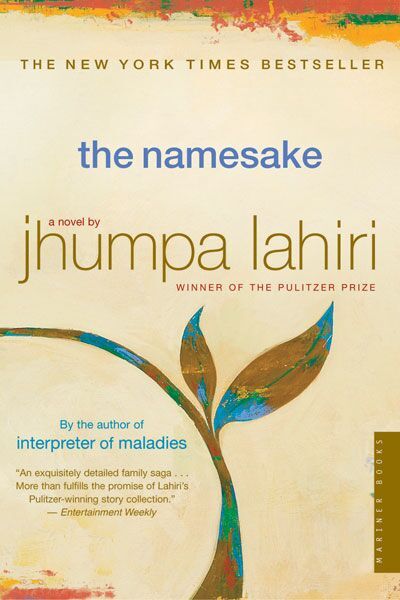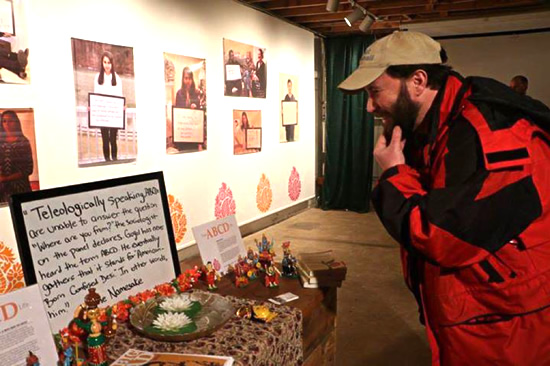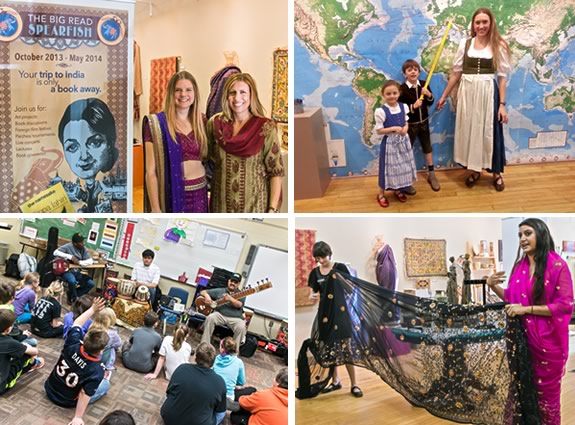The Namesake

Overview
National Endowment for the Arts creative writing fellow Jhumpa Lahiri is known publicly by her nickname because her kindergarten teacher deemed it easier to pronounce than her proper name, Nilanjana Sudeshna. Born to Bengali émigré parents and newly arrived in the United States from London, she had to grapple early with questions of identity, and the impact of this is palpable in The Namesake. In this 2003 bestseller by the Pulitzer-prize-winning author, two generations of a Bengali-American family in Massachusetts struggle between new and old, assimilation and cultural preservation, striving toward the future and longing for the past. This is “a story of guilt and liberation; it speaks to the universal struggle to extricate ourselves from … family and obligation and the curse of history” (Boston Globe). The novel “beautifully conveys the émigré’s disorientation, nostalgia, and yearning for tastes, smells, and customs left behind” (Los Angeles Times Book Review). Lahiri can be seen in a cameo as “Aunt Jhumpa” in the 2006 film adaptation.
“My grandfather always says that’s what books are for…to travel without moving an inch.” —from The Namesake
Overview
National Endowment for the Arts creative writing fellow Jhumpa Lahiri is known publicly by her nickname because her kindergarten teacher deemed it easier to pronounce than her proper name, Nilanjana Sudeshna. Born to Bengali émigré parents and newly arrived in the United States from London, she had to grapple early with questions of identity, and the impact of this is palpable in The Namesake. In this 2003 bestseller by the Pulitzer-prize-winning author, two generations of a Bengali-American family in Massachusetts struggle between new and old, assimilation and cultural preservation, striving toward the future and longing for the past. This is “a story of guilt and liberation; it speaks to the universal struggle to extricate ourselves from … family and obligation and the curse of history” (Boston Globe). The novel “beautifully conveys the émigré’s disorientation, nostalgia, and yearning for tastes, smells, and customs left behind” (Los Angeles Times Book Review). Lahiri can be seen in a cameo as “Aunt Jhumpa” in the 2006 film adaptation.
This title is no longer available for programming after the 2018-19 grant year.
Introduction to the Book
A father and mother, a son and daughter: two generations of a typical Bengali–American family, poised uneasily atop the complex and confounding fault lines common to the immigrant experience. Jhumpa Lahiri's novel The Namesake deftly demonstrates how the familiar struggles between new and old, assimilation and cultural preservation, striving toward the future and longing for the past, play out in one particular set of foreign-born parents and their American-born children.
In the novel's opening pages, Ashima Ganguli, who left India to join her husband Ashoke in America, is about to deliver their first child, a son. Following Bengali custom, the child is to have two names—a pet name, for use only by family and close friends, and a "good" name, to be used everywhere else. Almost by mistake, the boy comes to be known as Gogol, named for his father's favorite Russian author. In a harrowing flashback, the reason for Ashoke's attachment to the Russian writer is revealed.
Gogol's father embraces their new life, while his mother longs for her homeland. As Gogol enters school, they attempt to convert his unusual name to a more typical one, but the boy stolidly rejects the transition, refusing to become, as he thinks of it, "someone he doesn't know." Soon he regrets his choice, as the name he's held onto seems increasingly out of place.
The novel's finely wrought descriptions of Bengali food, language, family customs, and Hindu rituals draw us deep inside the culture that Gogol's parents treasure while highlighting his alienation from it. Gogol finishes school, becomes an architect, falls in love more than once, and eventually marries, without ever fully embracing his heritage. His decades-long unease with his name is a perfect distillation of the multiple dislocations—cultural, historic, and familial—experienced by first-generation Americans. At the novel's climax, when loss compounds loss and Gogol's family structure is forever changed, he begins to understand, at least in part, his parents' longing for the past, and the sacrifices they made to help him be what he is—truly American.
Major Characters in the Book
Ashoke Ganguli
A Bengali man who comes alone to the U.S. to study electrical engineering. Weds Ashima Bhaduri via an arranged marriage in Calcutta. Father of Gogol and Sonia, a dedicated but undemonstrative family man with a lifelong attachment to Russian literature.
Ashima Ganguli
Journeys alone to the U.S. shortly after marrying Ashoke. Caring mother to Gogol and Sonia; stays in close touch with her family in India and maintains a growing network of Bengali friends and neighbors, as her family moves from city to city for Ashoke's career. At the end of the novel she bifurcates her life to spend time in the U.S. with her children and in India with her family of origin.
Gogol Ganguli
The "namesake" of the title, named after his father's favorite Russian writer, Nikolai Gogol (1809–1852). A first–generation Indian American whose uneasiness with his name exemplifies his difficulties in fitting in, either to his parents' expatriate world or to the world inhabited so comfortably by his American peers.
Sonia Ganguli
Gogol's younger sister, who is less troubled than he by their shared cultural heritage, or by the strictures and oddities of their household. Her steadiness—a peaceful life with her mother after her father's death, and a happy marriage—throws Gogol's chronic discomforts into sharper relief.
Maxine Ratliff
The only child of wealthy, urbane New Yorkers, and Gogol's first post–college girlfriend. Maxine represents so many things that Gogol believes he values: art and music, sophistication, and ease in the world.
Moushumi Mazoomdar
Appears first as the book-reading child of a neighboring Bengali family, noteworthy only because of her aloof air and deliberate English accent. The adult Moushumi resurfaces as Gogol's love interest and eventual wife. She too stages a rebellion against her heritage, living alone in Paris for a time.
"He is afraid to be Nikhil, someone he doesn't know." —Jhumpa Lahiri, from The Namesake
- In the opening scene, Ashima is making a snack for herself, and near the end she prepares samosas for a party. Food plays a large role throughout the novel. How does the author use food to evoke specific emotions?
- This novel, less than 300 pages long, spans more than 30 years. What techniques does the author use to compress time and move the story forward?
- Much of the story is told in the present tense. Why would the author make this unusual choice?
- Maxine and her parents live in an elegant townhouse, while Gogol's family has an ordinary suburban house. How does the author use these two settings to help the reader understand these different families?
- Gogol's discomfort with his name is one of the novel's main themes. Also, Ashima never addresses her husband by his given name, because such a name is "intimate and therefore unspoken." What other names in the novel are important, and why?
- Gogol's sister Sonia is present in only a few scenes in the novel, and the story is never told from her point of view. Why do you think that Lahiri left her a less-developed character than Gogol? What purpose does she serve in the story?
- There are two train accidents in the novel, one involving Gogol and one his father. How are the two accidents linked, and how do they serve to drive the characters closer together, or farther apart?
- How does Gogol evolve as a character, from his first days of school to his life as an adult, with a profession and a wife? How does he stay the same?
- The author has stated in multiple interviews that she strives to write in a plain, unadorned way. What impact does her chosen style have on the reader?
- The Namesake is written in third person, but various characters serve as the "point of view" character, telling the story from their perspective. How many different "point of view" characters are there, and how does the author shift the narrative between them?
The Namesake Celebrates Indian Culture and Initiates Dialogue in Charlottesville, Virginia
“[We offered] a panel discussion on arranged marriage, a live arts night at the University of Virginia featuring performances by award-winning student singing and dancing groups, henna programs, a photograph exhibit titled That ABCD Life that featured the experiences of “American Born Confused Desi” and the premier of the film The Ashimas of Charlottesville, which followed women who migrated from India directly to our community. This was followed by a panel discussion with the women from the film moderated by the filmmaker. The Indian community also invited the wider community to a potluck Holi spring celebration in honor of the Big Read. A joint concert we presented with SPICAMACAY and the Hindu Students Council drew 320 adults and 160 students to a performance by teens, university students and adult community members at the University.

|
“The Namesake’s themes of the universal immigrant experience, family relations and the struggle for identity while transitioning from childhood to adulthood resonated with our readers. Book discussion members shared their families’ immigration stories as well as insights on intergenerational relations. The Indian community was thrilled to share their traditions with wider community, such as when they opened participation in their annual Holi celebration to Big Read participants. One young man frequently posted flyers for his mother’s Bengali cooking class at the library. We asked him if he thought his mother might like to do a program for our Big Read. He came back the next week to tell us that his mother loved The Namesake, that it was her story in America and that she insisted that we work together.”
– from a report by the Jefferson Madison Regional Library, an NEA Big Read grant recipient in FY 2014-15.
The Namesake Gets People Talking about the Meaning of Names in Reading, Massachusetts
“Each attendee had a place setting with their name, its origin and meaning. A big ‘nametag’ was provided to each staff member to write down and share the meaning of their name, why that name was chosen and who, if anyone, was their namesake. This proved to be a really wonderful way to connect to The Namesake; fostering conversations around culture, family, and identity in the novel as well as our own lives. Due to the success of this activity we continued to use it in all the discussion groups we facilitated to great effect.”

|
– from a report by the Reading Public Library, an NEA Big Read grant recipient in FY 2013-2014.
Community Members Learn How to Wrap Saris in Spearfish, South Dakota
The Matthews Opera House and Arts Center (MOH) created a successful series of events that included art projects, a film festival, library story times, art exhibits, school residencies, and musical performances. MOH staff, in conjunction with its partners all over town and a student studying abroad in India, worked to make sure that the program gave participants an “eye opening” experience by exposing them to issues and ways of life different from their own.

|
– from a report by the Matthews Opera House and Arts Center, an NEA Big Read grant recipient in FY 2013-2014.


